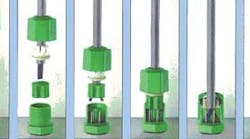A Reader Writes:
Our I/O and terminal block vendor is pushing insulation displacement connection (IDC) technology. It looks slick, but were not sure it will hold up in the plant. Does anybody have experience with IDC terminations in chemical plant environments? Is there any place they should be avoided? What IDC characteristics should we be looking for?
--from December 2002 CONTROL
Solutions:
No Problem
We have a considerable amount of experience with our IDC terminal blocks used in chemical plants and other industrial environments. Since the introduction of our Terminator insulation displacement terminal block system in Australia and Europe six years ago, we can point to successful installations in chemical plants, cement plants, pipelines, mines, metal processing plants, lumber mills, sugar mills, dairy plants, water purification plants, and tire and automotive manufacturing facilities.
The applications range from connections to PLCs and other control systems, marshalling cabinets located throughout the chemical plant, motor control centers, test equipment, HVAC wiring, security and energy management wiring, and local control panels in the plants, to a wide variety of instrumentation.
The Terminator is the most widely used IDC terminal block in the industry with more installed points of connection in a more varied variety of applications than any other product. In fact one interesting application was the recent Olympic Park in Sydney, Australia, where several control systems located in numerous buildings and locations were wired completely with the IDC terminal block system.
The characteristics one should look for in an IDC terminal block include:
- The terminal block housing should be designed such that the housing provides insulation support on both sides of the termination contact thereby protecting the wire connection in the event of vibration (1 in figure)
- The contact should provide a gas-tight connection, which is necessary to stand up to the environments in an industrial application with corrosion or contact problems, to provide years of reliable operation (2 in figure).
- The contact should be designed in such a way to eliminate any potential damage to stranded wire during wire termination. In the case of the Terminator, the contact is at a 45-degree angle to the wire, thereby eliminating any potential problems while ensuring a constant axial force on the wire during the life of the termination (3 in figure).
- The contact should be made out of a special spring-type copper alloy and should be nickel-plated to provide a high-quality electrical connection and prevent any problems associated with corrosion.
- The contact should be designed to be re-terminated multiple times without deformation to the contact area. The Terminator is designed to be re-terminated up to 50 times.
- The terminal block should have test reports validating the ability to stand up in areas of vibration, corrosion, and current-carrying capability and should include a wide range of international approvals such as UL, CSA, DEMKO, SEMKO, FINKO, Lloyds, etc.
Howard Minnick, President
Automation Systems Interconnect, www.asi-ez.com
Saves Money Several Ways
IDC technology is designed to save up to 60% of installation time and can be terminated with no special tools or stripping of the conductors. You should look for connections between the contact and the wire to be gas-tight. This ensures a reliable solution over time in harsh environments. The contact should have good corrosion resistance, so look for a metal body that is plated copper alloy. The IDC contact should be manufactured in a shock-proof housing to prevent electrical shock or shorting. It should be designed to industry standard pin spacing and be capable of withstanding industrial currents and voltages.
...Most chemical plant applications involve hazardous atmospheres, where termination points and junction boxes must be installed in explosion-proof enclosures to ensure safety. According to NEC 2002 [505.8 (F)], termination devices that are rated increased safety [UL 2279, pt.7, FM 3600 (ISA 12.16.01)] can be installed in the hazardous location (Class I, Zone 1), in appropriate increased safety enclosures, saving significant cost and labor over explosion-proof devices.
Davis Mathews, Product Manager
Phoenix Contact, www.phoenixcon.com
Resist Degradation
Rockwell Automation recently launched its line of IDC terminal blocks. While we cannot speak first-hand of application experience, there should be nothing inherently different in an IDC connection from a spring clamp connection relative to environmental issues.
Our IDC connection has a lower possibility of degradation because of the constant spring force exerted on the terminated wire. This is accomplished through a compressed stainless steel spring that surrounds the insulation cutting blade. We believe this provides the most secure connection.
Available for implementations worldwide, IDC terminal blocks have received UL recognition as well as CSA, IEC, and CE certification.
Keith Cumiskey, Product Manager
Rockwell Automation, www.rockwellautomation.com
Aprils Problem
What DAQ System Should We Use?
We are adding instrumentation to a number of pieces of standalone equipment. Recorders, programmable digital multimeters, and PCs with DAQ cards have been proposed. How should we decide? What are the fundamental differences in the capabilities of these types of systems? Are there other approaches we should consider?
Please send us your comments, suggestions, or solutions to this problem. Solutions will be published in our April issue, but we need your responses by March 7 to meet our editorial production deadlines. If you have a solution to this problem, or a problem of your own that you would like to pose to other colleagues, mail, fax, or e-mail it to CONTROL Problem Solving Ideas, 555 W. Pierce Rd., Suite 301, Itasca, IL 60143; Fax 630/467-1124; e-mail [email protected]




